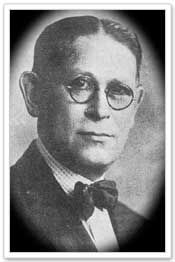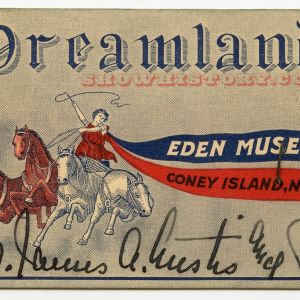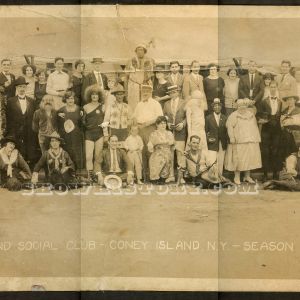Samuel Gumpertz

S.W. Gumpertz, or Samuel Gumpertz was born in Washington, D.C., in 1868, but soon after moved with his family to St. Louis, and at the tender age of nine, he ran away to join the circus–in this case, the Montgomery and Queens Circus. For his ability to walk on his hands and do flip-flops, he was promoted to the job of “top mounter” with the Jackley family of acrobats, although this particular line of work lost its appeal one day when he somersaulted from the top of a human pyramid and landed on his head.
Three years later, Gumpertz was taking children’s parts at the Tivoli Opera House in San Francisco. After his voice changed, he went to Texas and worked as a rancher there until Buffalo Bill’s Wild West extravaganza came to nearby Abilene. Gumpertz joined the show and eventually performed as one of the Congress of Rough Riders of All Nations. Following the wind more than anything, he then took a number of jobs, producing Shakespeare plays and running two theaters even as he managed Shadow the Strongman and the inimitable Harry Houdini, just then making his bid for stardom. Between 1897 and 1903, Gumpertz operated a chain of 17 theaters for Colonel John D. Hopkins, a business acquaintance of Buffalo Bill’s.
Gumpertz began his career at Coney Island’s Dreamland in 1904, the year it opened, with a smash hit: a miniature village populated by very small people. Lilliputia, also known as Midget City, was built to resemble 15th-century Nuremberg, except that everything was smaller. The inhabitants, gathered by Gumpertz from expositions around the country, had their own parliament, their own fire department (which regularly responded to false alarms), and their own theater. For increased effect, Gumpertz installed a few giants to wander this experimental community from time to time.
In 1908 or 1909, the owners of Dreamland, increasingly concerned about profits, hired Gumpertz as general manager. Though he upgraded many attractions and rides, his forte was in human oddities and circus attractions. He brought a tribe of Igorettes, complete with a village, from the Philippines, and convinced Frank C. Bostock to combine his European and American trained animal shows into a season-long show in a permanent arena. Gumpertz also recruited other circus acts to perform in the center of Dreamland’s lagoon. To promote some of these attractions, he hired Omar Sami, considered by some to be the greatest barker of all time for his soft yet mesmerizing Hindu accent.
When Dreamland burned down on opening day of the 1911 season, Gumpertz immediately organized the Dreamland Circus Sideshow in a tent on Surf Avenue. The show continued through the 1920s and was influential in attracting freak shows to Coney Island after movies had eclipsed illusion rides in popularity. For many years, Gumpertz was the promoter for “Zip What Is It,” the famous “pinhead” performer originally employed by P.T. Barnum and later immortalized in the underground comic character, Zippy the Pinhead. In 1929, on the eve of the Depression, Gumpertz left Coney Island to work with the Ringling Brothers, and so ended up where he had begun: with the circus.
— From http://www.pbs.org/wgbh/amex/coney/peopleevents/pande02.html
Related Images
THIS CONTENT IS RESTRICTED TO SUBSCRIBERS
Join now or LOG IN to view this content, you won’t be disappointed!



